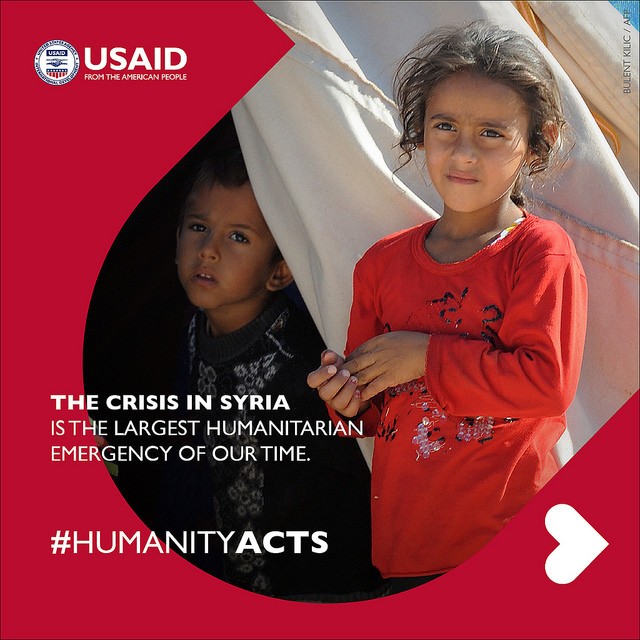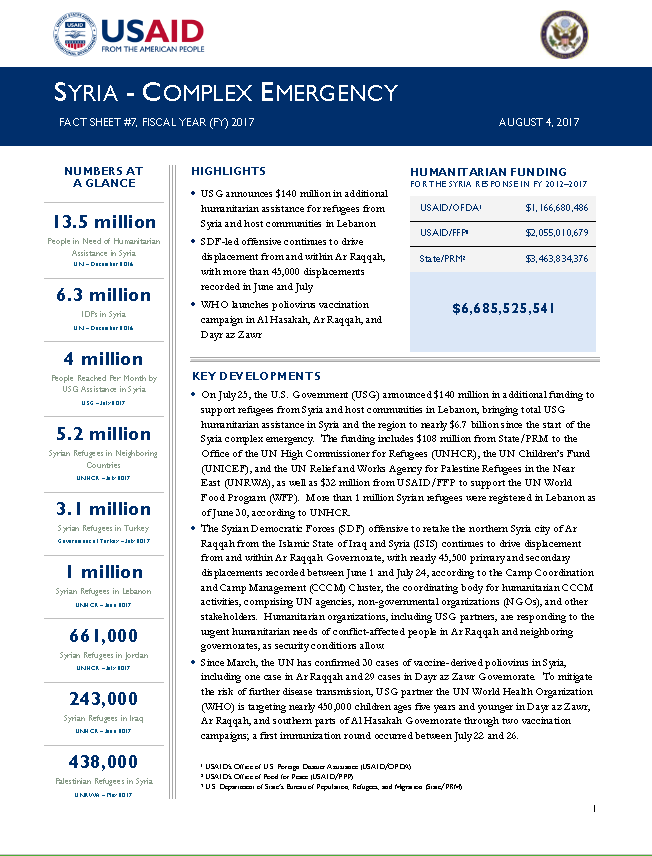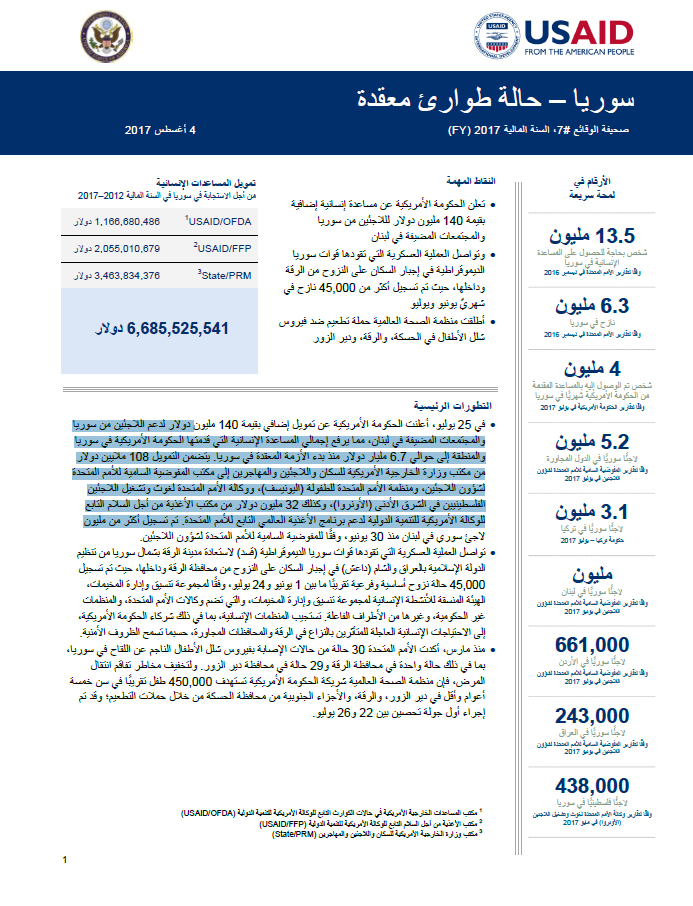- What We Do
- Agriculture and Food Security
- Democracy, Human Rights and Governance
- Economic Growth and Trade
- Education
- Ending Extreme Poverty
- Environment and Global Climate Change
- Gender Equality and Women's Empowerment
- Global Health
- Water and Sanitation
- Working in Crises and Conflict
- Disaster Assistance
- Political Transition Initiatives
- Conflict Mitigation and Prevention
- Countering Violent Extremism
- Disaster Risk Reduction
- Peacebuilding and Reconciliation
- Providing Safe & Secure Environments for Development
- Recovering From Crisis
- Resilience
- Tech Challenge for Atrocity Prevention
- World Humanitarian Day
- U.S. Global Development Lab
August 04, 2017
Highlights
USG announces $140 million in additional humanitarian assistance for refugees from Syria and host communities in Lebanon
SDF-led offensive continues to drive displacement from and within Ar Raqqah, with more than 45,000 displacements recorded in June and July
WHO launches poliovirus vaccination campaign in Al Hasakah, Ar Raqqah, and Dayr az Zawr
Key Developments
On July 25, the U.S. Government (USG) announced $140 million in additional funding to support refugees from Syria and host communities in Lebanon, bringing total USG humanitarian assistance in Syria and the region to nearly $6.7 billion since the start of the Syria complex emergency. The funding includes $108 million from State/PRM to the Office of the UN High Commissioner for Refugees (UNHCR), the UN Children’s Fund (UNICEF), and the UN Relief and Works Agency for Palestine Refugees in the Near East (UNRWA), as well as $32 million from USAID/FFP to support the UN World Food Program (WFP). More than 1 million Syrian refugees were registered in Lebanon as of June 30, according to UNHCR.
The Syrian Democratic Forces (SDF) offensive to retake the northern Syria city of Ar Raqqah from the Islamic State of Iraq and Syria (ISIS) continues to drive displacement from and within Ar Raqqah Governorate, with nearly 45,500 primary and secondary displacements recorded between June 1 and July 24, according to the Camp Coordination and Camp Management (CCCM) Cluster, the coordinating body for humanitarian CCCM activities, comprising UN agencies, non-governmental organizations (NGOs), and other stakeholders. Humanitarian organizations, including USG partners, are responding to the urgent humanitarian needs of conflict-affected people in Ar Raqqah and neighboring governorates, as security conditions allow.
Since March, the UN has confirmed 30 cases of vaccine-derived poliovirus in Syria, including one case in Ar Raqqah and 29 cases in Dayr az Zawr Governorate. To mitigate the risk of further disease transmission, USG partner the UN World Health Organization (WHO) is targeting nearly 450,000 children ages five years and younger in Dayr az Zawr, Ar Raqqah, and southern parts of Al Hasakah Governorate through two vaccination campaigns; a first immunization round occurred between July 22 and 26.
Syria Complex Emergency - Fact Sheet #7 2017 ![]() (pdf - 263k)
(pdf - 263k)
Numbers At A Glance
13.5 million
6.3 million
4 million
5.2 million
3.1 million
1 million
661,000
243,000
438,000
Humanitarian Funding
To Syria Humanitarian Response
FY 2012 - FY 2017
| USAID/OFDA | $1,166,680,486 |
| USAID/FFP | $2,055,010,679 |
| State/PRM | $3,463,834,376 |
| TOTAL | $6,685,525,541 |
سوريا – حالة طوارئ معقدة ![]() (pdf - 462k)
(pdf - 462k)
INSECURITY AND POPULATION DISPLACEMENT
The CCCM Cluster recorded more than 950,500 displacements from conflict-affected areas throughout Syria between July 2016 and July 2017, with an estimated 55,500 new displacements recorded during June 2017 alone. The overall figure includes approximately 911,600 displacements from northern Syria, including Al Hasakah, Aleppo, Ar Raqqah, Dayr az Zawr, Hamah, Homs, Idlib, and Latakia governorates, and nearly 39,000 displacements from southern Syria’s As Suwayda’, Damascus, Dar’a, and Rif Damascus governorates.
Northern Syria
In and around the city of Ar Raqqah, heavy clashes between the SDF and ISIS continue, resulting in civilian casualties, displacement, and humanitarian need. As of mid-July, SDF forces had surrounded the city and reportedly entered Ar Raqqah’s old city, according to the UN Office for the Coordination of Humanitarian Affairs (OCHA). Although progressing relatively quickly, OCHA anticipates that airstrikes and heavy clashes will continue to affect the city in the coming weeks as SDF forces advance on the remaining ISIS-held neighborhoods; SDF forces had reportedly taken control of 20–30 percent of the city as of mid-July.
As of July 28, humanitarian organization estimated that between 10,000 and 25,000 civilians remained in the city of Ar Raqqah. Civilians remaining in the city are facing increasingly dire conditions, with limited access to food, safe drinking water, and essential services. Relief agencies anticipate significant population outflows from the city to continue in the coming weeks as humanitarian conditions deteriorate further.
Despite extensive damage to infrastructure and limited public services, internally displaced persons (IDPs) continue to return to areas of origin in Aleppo. As of late June, nearly 273,500 people had returned to newly accessible areas in the city of Aleppo since Syrian Arab Republic Government (SARG) forces gained control of the eastern portion of the city in December 2016, according to OCHA. Relief agencies report recent improvements to essential services available in the city, including the resumption of operations at two SARG-supported bakeries, delivery of safe drinking water to all neighborhoods, and approval for private generator operators to supply electricity to households. Ongoing activities to improve living conditions, such as debris removal, may encourage additional returns to the city, OCHA reports.
Humanitarian conditions continue to deteriorate in the city of Dayr az Zawr, where as many as 93,500 people remain besieged by ISIS, with limited access to food and essential services, particularly medical care, according to OCHA. In eastern Dayr az Zawr Governorate, SARG airstrikes targeting ISIS prompted an unconfirmed number of households to flee north into Al Hasakah in recent weeks.
Southern and Central Syria
On July 9, a ceasefire agreement—brokered by the USG, the Government of the Russian Federation, and the Government of the Hashemite Kingdom of Jordan—went into effect in southwestern Syria, including Dar’a, Quneitra, and western parts of As Suwayda’ governorates, where increased hostilities among the SARG and armed opposition groups (AOGs) had persisted since early June. International media reported reduced levels of fighting in areas of ceasefire implementation as of late July, enabling SARG civil defense members to accelerate the clearance of unexploded ordnances in some areas.
SARG forces announced the implementation of a temporary cessation of hostilities in parts of Rif Damascus’s Eastern Ghouta region on July 22; conflict among AOGs and the SARG had escalated in the two weeks preceding the agreement. As of late July, the UN had reported several breaches to the ceasefire agreement, including airstrikes on the towns of Arbin, Douma, Zamalka, and Otaya, which have resulted in numerous civilian deaths and injuries.
Approximately 50,000 Syrians remain stranded along the Syria–Jordan border berm, with limited access to humanitarian assistance and essential services. On July 18, an explosion at the informal Rukban settlement located along the border berm killed three children and injured five others, according to the UN. The UN continues to advocate for regular and uninterrupted humanitarian assistance to populations stranded at the berm, particularly amid the deteriorating humanitarian and security situation.
HUMANITARIAN ACCESS
As of August 2, the UN and its partners had deployed 30 interagency convoys across conflict lines to UN-identified besieged and hard-to-reach areas in 2017, delivering multi-sector assistance to more than 733,000 conflict-affected people in Syria, including an estimated 212,700 people in UN-identified besieged areas. In addition, WFP-led airdrops continue to facilitate the delivery of food and nutrition assistance, medical supplies, and other relief items to the besieged city of Dayr Az Zawr. As of August 2, the UN agency had conducted 121 airdrops and delivered nearly 2,500 metric tons (MT) to Dayr az Zawr in 2017.
Since becoming operational in mid-June, the overland route to Al Hasakah’s city of Qamishli has improved the delivery of humanitarian assistance to populations in need throughout northeastern Syria, including to people displaced from and within Ar Raqqah. Through use of the route, WFP had transferred food assistance for an estimated 110,000 people in northeastern Syria as of early July. WFP continues to use the route to conduct regular food and relief deliveries, enabling the UN agency to discontinue its airlift operation between Damascus and Qamishli in late June; the air bridge between Damascus and Qamishli had been in place since mid-2016.
On July 30, the UN and the Syrian Arab Red Crescent delivered food commodities and other relief supplies for an estimated 7,200 people living in the besieged town of Nashabiyeh in Eastern Ghouta for the first time in five years, according to OCHA. International media reports note that aid deliveries to Eastern Ghouta have increased since the SARG–AOG temporary cessation of hostilities began on July 22, although daily SARG airstrikes and artillery attacks have continued in some AOG-held areas in the region.
On June 22, despite ongoing hostilities, an interagency convoy conducted a delivery to the hard-to-reach city of Ar Rastan in northern Homs for the first time since March 30. The 43-truck convoy delivered food assistance, health items, nutrition supplies, and other relief commodities to benefit approximately 107,500 people. The convoy is the second to reach Homs’s Ar Rastan District in June; an earlier convoy accessed the town of Talbiseh on June 15.
AGRICULTURE AND FOOD SECURITY
Improved humanitarian access and security in some parts of Syria are contributing to the slow recovery of trade and markets, including in eastern Aleppo city, according to the latest Crop and Food Security Assessment Mission (CFSAM) conducted by WFP and the UN Food and Agriculture Organization (FAO) and released on July 18. Nonetheless, food commodity prices throughout the country remain well above those recorded two to three years ago. The CFSAM reports an estimated total wheat production of 1.8 million MT in 2017—a 12 percent increase as compared to the record low reported in 2016—due to improved rainfall and better access to agricultural land in some areas. However, average wheat production remains at less than half of recorded pre-conflict levels. Livelihood opportunities in both the formal and informal sectors also improved somewhat, resulting in increased purchasing power for laborers and pastoralists as compared to December 2016, although their purchasing power remains low relative to 2014 and 2015.
Despite reported improvements in some areas, more than 30 percent of Syrian households experience inadequate food consumption levels and limited dietary diversity. The situation is most severe among households living in besieged or hard-to-reach areas, as well as for IDPs. Based on the assessment, FAO and WFP report that as many as 6.9 million people in Syria are experiencing food insecurity, with an additional 5.6 million Syrians who would likely face more severe conditions without regular food assistance.
In June, USAID/FFP partner WFP provided food assistance for more than 4 million people throughout Syria, reaching 99 percent of individuals targeted for assistance. WFP also dispatched specialized nutrition products for the prevention of acute malnutrition in nearly 74,000 children ages 6–23 months and nutrition supplements for nearly 1,400 children ages 6–59 months and pregnant and lactating women.
Humanitarian organizations, including USG partners, are responding to the urgent food assistance and other humanitarian needs of conflict-affected people in Ar Raqqah and neighboring governorates as security conditions allow. In the first half of July, relief organizations engaged in food security activities reached nearly 107,000 beneficiaries in Al Hasakah, Aleppo, and Ar Raqqah with ready-to-eat rations and other food commodities
HEALTH AND WASH
As of August 1, the UN had confirmed 30 cases of vaccine-derived poliovirus in Syria, including 29 cases originating in Dayr az Zawr’s Al Mayadin District and one case originating in Ar Raqqah’s Tel Abyad District. Although rare, vaccine-derived cases typically occur in environments with low immunization coverage and poor sanitation that leave populations highly susceptible to the disease, which pre-dominantly spreads via fecal–oral transmission.
In response to the poliovirus outbreak, USG partner WHO is targeting nearly 450,000 children ages five years and younger, including 120,500 internally displaced and refugee children, through two vaccination campaigns, each comprising two rounds of immunizations. The first round covering Dayr az Zawr and southern parts of Al Hasakah’s Shadadah sub-district occurred between July 22 and 26, reaching nearly 260,000 children; the second round is scheduled for August 19–23. As of August 1, preparations remained underway for the Ar Raqqah vaccination campaign.
Between January and June, USG partner UNICEF assisted more than 3.7 million people in Syria through water, sanitation, and hygiene (WASH) services. UNICEF repaired water networks in the cities of Damascus and Aleppo, benefiting more than 2 million residents combined. The agency continues to supply disinfectants necessary to treat water networks across Syria, helping to ensure civilians’ access to potable water. UNICEF also provided emergency water supplies to more than 784,000 people in Al Hasakah, Aleppo, Ar Raqqah, Rif Damascus, and Hamah through water trucking.
PROTECTION
The military offensive in Ar Raqqah and resultant displacement continue to exacerbate humanitarian protection concerns, particularly during screening and sponsorship processes enforced by the SDF and the Autonomous Administration (AA), a Democratic Union Party-affiliated governance body in northern Syria, according to a recent report from the Syria Protection Monitoring Task Force. The report identifies several protection concerns, including the arbitrary detention of IDPs fleeing the Ar Raqqah offensive to other areas of Ar Raqqah and to Aleppo; the confiscation of identification documents; the inadequate provision of humanitarian services; and movement restrictions for IDPs, among others. The report also emphasizes the fluid nature of the displacement situation and AA- and SDF-enforced screening and sponsorship procedures, noting that the Protection Cluster will continue to monitor the situation closely.
REFUGEE ASSISTANCE
State/PRM partner UNHCR had registered nearly 5.2 million Syrian refugees in neighboring countries, including Iraq, Jordan, Lebanon, and Turkey, as well as Egypt and other parts of northern Africa, as of July 27. Turkey remains the largest host nation, with more than 3.1 million Syrian refugees registered in the country.
On July 25, the USG announced more than $140 million to support Syrian and Palestinian refugees from Syria and host communities in Lebanon, including $108 million from State/PRM and $32 million from USAID/FFP. State/PRM funding is supporting three UN agencies—UNHCR, UNICEF, and UNRWA—to continue cash assistance activities, humanitarian protection programs, immunization campaigns, and medical service provision, while USAID/FFP funding is enabling WFP to provide electronic food vouchers to 750,000 refugees. More than 1 million registered Syrian refugees were living in Lebanon as of the end of June, according to UNHCR.
State/PRM partner UNRWA conducted a second round of cash distributions for Palestinian refugees in Syria between May 2 and June 22, reaching more than 409,500 people with assistance. On July 23, UNRWA commenced a third round of cash distributions, providing up to 418,000 Palestinian refugees each with $64 in cash assistance to help cover their needs for two months. In addition, UNWRA provided support to nearly 2,000 Palestinian refugees at nine collective shelters in Syria’s Damascus and Rif Damascus governorates throughout June. The agency also delivered safe drinking water to refugees and host communities and distributed nearly 30,800 WASH items, including diapers, hygiene kits, and sanitary napkins, to vulnerable populations across the two governorates.
CONTEXT
Following the commencement of peaceful demonstrations against the SARG in March 2011, President Bashar al-Asad pledged legislative reforms. However, reforms failed to materialize, and SARG forces loyal to President al-Asad began responding to demonstrations with violence, leading armed oppositions groups to retaliate.
At a November 2012 meeting in Doha, Qatar, Syrian opposition factions formed an umbrella organization—the National Coalition for Syrian Revolutionary and Opposition Forces, also known as the Syrian Coalition. The USG recognized the coalition as the legitimate representative of the Syrian people on December 11, 2012. On March 19, 2013, the Syrian Coalition established the Syrian Interim Government, which opposes the SARG and is based in decentralized locations throughout opposition-held areas of Syria.
On July 14, 2014, the UN Security Council (UNSC) adopted UN Security Council Resolution (UNSCR) 2165, authorizing UN cross-border and cross-line delivery of humanitarian aid to conflict-affected populations without SARG approval. The resolution permits the UN’s use of four border crossings from Turkey, Jordan, and Iraq—in addition to other crossings already in use by UN agencies—for delivery of humanitarian assistance into Syria. The resolution also establishes a monitoring mechanism under the authority of the UN Secretary-General and with the consent of neighboring countries to ensure that deliveries across these border points contain only humanitarian items. The UNSC has subsequently adopted several resolutions renewing the mandate of UNSCR 2165, most recently in December 2016 with the adoption of UNSCR 2332, extending the authorities granted until January 2018.
Prior to the start of the conflict, UNRWA had registered approximately 560,000 Palestinian refugees in Syria, with more than 80 percent living in and around Damascus. Intense fighting in and around some Palestinian camps and neighborhoods has significantly affected Palestinian refugees in Syria. UNRWA estimates that approximately 60 percent of Palestinian refugees are displaced within Syria, with a further 110,000 Palestinian refugees displaced in neighboring countries. Syria also hosts an estimated 24,000 Iraqi refugees and asylum seekers, primarily in the greater Damascus area, as well as more than 3,200 refugee persons of concern from other countries.
PUBLIC DONATION INFORMATION
The most effective way people can assist relief efforts is by making cash contributions to humanitarian organizations that are conducting relief operations. A list of humanitarian organizations that are accepting cash donations for disaster responses around the world can be found at www.usaid.gov/crisis/syria.
The USG encourages cash donations because they allow aid professionals to procure the exact items needed (often in the affected region); reduce the burden on scarce resources (such as transportation routes, staff time, and warehouse space); can be transferred very quickly and without transportation costs; support the economy of the disaster-stricken region; and ensure culturally, dietary, and environmentally appropriate assistance.










Comment
Make a general inquiry or suggest an improvement.